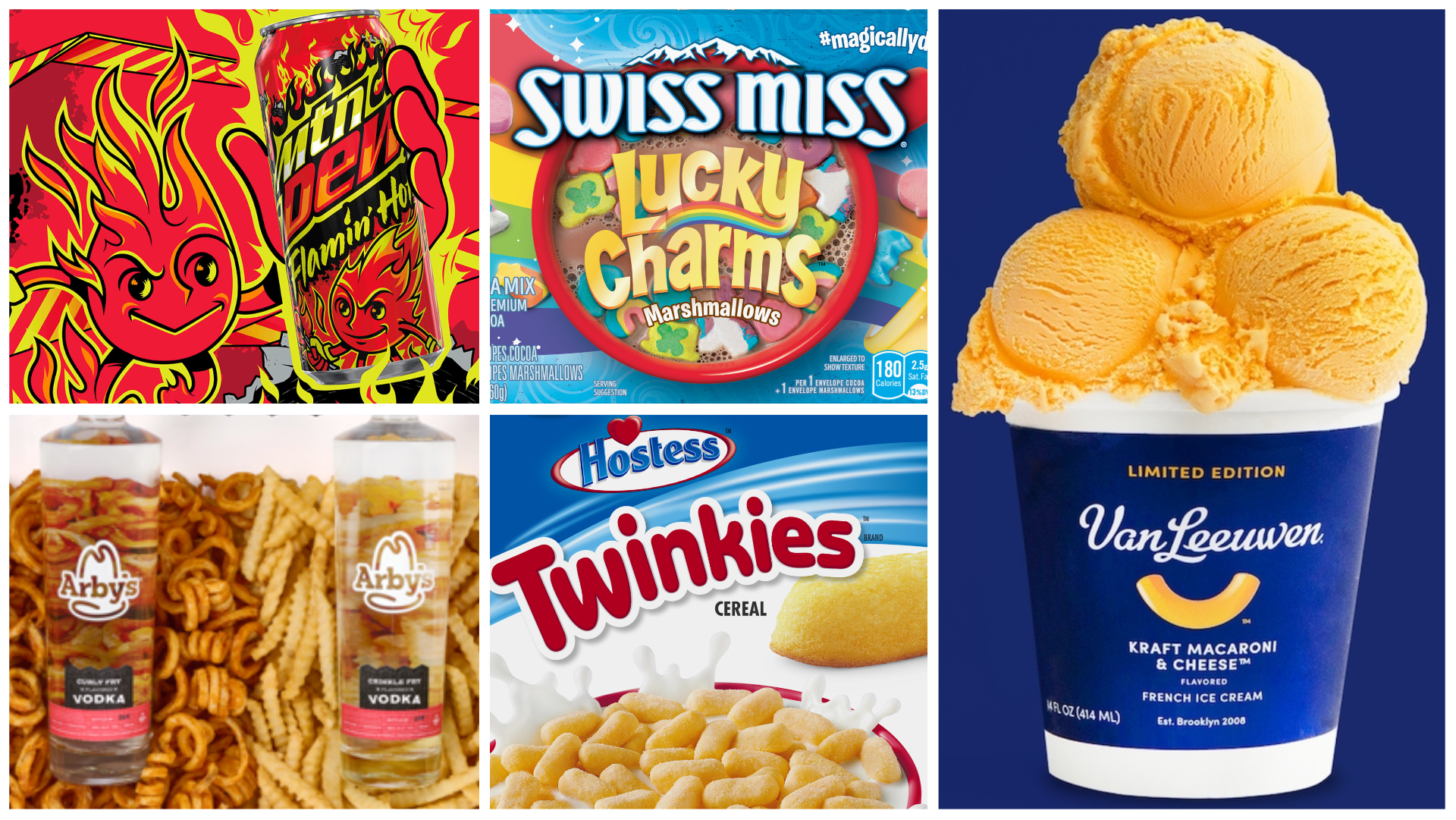The Rise Of Cross-Brand Mashups
How food and beverage brands are grabbing your attention with high-profile collaborations.
While standing in the checkout line at the supermarket, a flash of rainbow entered my peripheral vision. No, it wasn't a real rainbow, but it might as well have been. I swiftly turned my head, and there it was: in a bin near the breakfast aisle were Swiss Miss Lucky Charms, an instant hot chocolate with Lucky Charms marshmallows swapped in. It was the first time I'd ever seen such a product; I immediately texted my partner a picture.
"Lucky Charms hot chocolate is actually a pretty good idea," he replied. "I love those marshmallows." I admit I love those marshmallows too.
Of course, Swiss Miss Lucky Charms isn't the only eye-catching product mashup on the shelves. The past year alone has seen a huge uptick in cross-brand collaborations. In the food and beverage sector, a few recent examples include:
- Coca-Cola and music artist Marshmello teamed up for new limited-edition drink, a zero-sugar and zero-calorie Coke flavored with strawberry and watermelon.
- Oskar Blues brewery partnered with its favorite condiment brand to create French's Mustard Beer.
- For Lunar New Year, Dear Bella Creamery and Fly By Jing (both Asian-owned businesses) came up with "Dan Dan ice cream" inspired by the flavors of the Szechuan noodle dish.
- Taco Bell partnered with Truff hot sauce last year on its spicy Nacho Fries; the brand also reached into the snack aisle to create this summer's Big Cheez-It Tostada.
Why and how do cross-brand collaborations happen? What are the benefits of these partnerships, and how do companies measure the success of their collaboration campaigns? To find out, I reached out to brand strategists and marketing professionals for their insight. Their answers may surprise you.
Why brands collaborate on new products
To understand why brands collaborate, first look at where they come from, says John Fischer, a brand and marketing strategist based in New York.
"Each brand has a unique position, or 'personality,' and cross-brand collaboration is a way to bring forth that personality," he told me over Zoom. Brands are always looking for new audiences to whom they can show off that personality.
Nicolette Dantas, founder of Treat Day Creative, an LA-based public relations and marketing company, echoed this sentiment, explaining that collabs are a way to attract both consumer and media attention.
"Brands are collaborating to create a culturally relevant storyline," she told me via email. "While not every collaboration is political, it should be novel, and tap into the desires of a larger audience." In short, it gets people talking, both online and in real life.
Cross-brand collaborations have been happening for decades. Remember the 1992 McJordan Special at McDonald's, based on Michael Jordan's favorite pre-workout meal? Or the 1985 debut of Dairy Queen's Blizzard, sprinkled with Oreo cookie bits? These are some early successful brand collaborations, setting the template for all big-name partnerships to follow.
The benefits of brand collaborations
"As a publicist, I always encourage my clients to look into brand partnerships as a way to create new news in a creative and fresh way," says Dantas. The media attention that occurs from each side tapping into their own audiences means that both sides will also benefit. Smaller companies, especially niche ones, will be able to access customers in ways they haven't before.
But what about larger companies with an already loyal following, such as Coca-Cola? How do they benefit? Fischer says those companies aren't necessarily looking at it from a financial perspective. It's more about retaining customers' loyalty and maintaining continual brand awareness. With so many choices on the market these days, it's more important than ever to make a splash; collaborating with other brands (or in this case, a Grammy-nominated music artist) on a new product, however limited its run might be, keeps the brand relevant and fresh in people's minds.
How brand collaborations happen
Cross-brand collaborations tend to be opportunistic, says Fischer. While many companies have dedicated marketing and public relations departments as well as agencies who regularly pitch ideas to them, it's not uncommon for these professionals to gather regularly and seek out new opportunities.
Additionally, companies must also consider their goals and how those goals align with one another. Michelle Gabe, Director of Marketing at TRUFF, a gourmet hot sauce company, told me via email that goals must be specific: a brand looks at its target audience and seeks out companies (or partners) whose values align with its own.
"Partnering with like-minded brands allows us to reach new consumers while creating conversation-generating moments for both brands," Gabe said.
How companies measure success
Once a collaboration has come and gone, how do both parties measure its success? By asking specific questions.
"A great sign that the campaign is going well is the amount of hype created on the internet through engaging comments, UGC [user-generated content], media attention and more," says Gabe. How much are people talking about your product? How many of them are buying? How many are sharing news about it on social media? These are the quantitative methods that companies generally rely on to determine whether their collaborations are working.
At the end of the day, though, it's all about the brand narrative. Humans are social creatures, and we thrive on the stories and the feelings we get from hearing those stories. This means that the goal will always be, in some part, to hit upon an emotional nerve and generate "aha" moments for consumers.
Now, if you'll excuse me, I've got to head to the store to look for that strawberry- and watermelon-flavored Coke. I have an image of a fresh, relaxing summer afternoon on my mind, and I can't wait to tell my friends about it.
